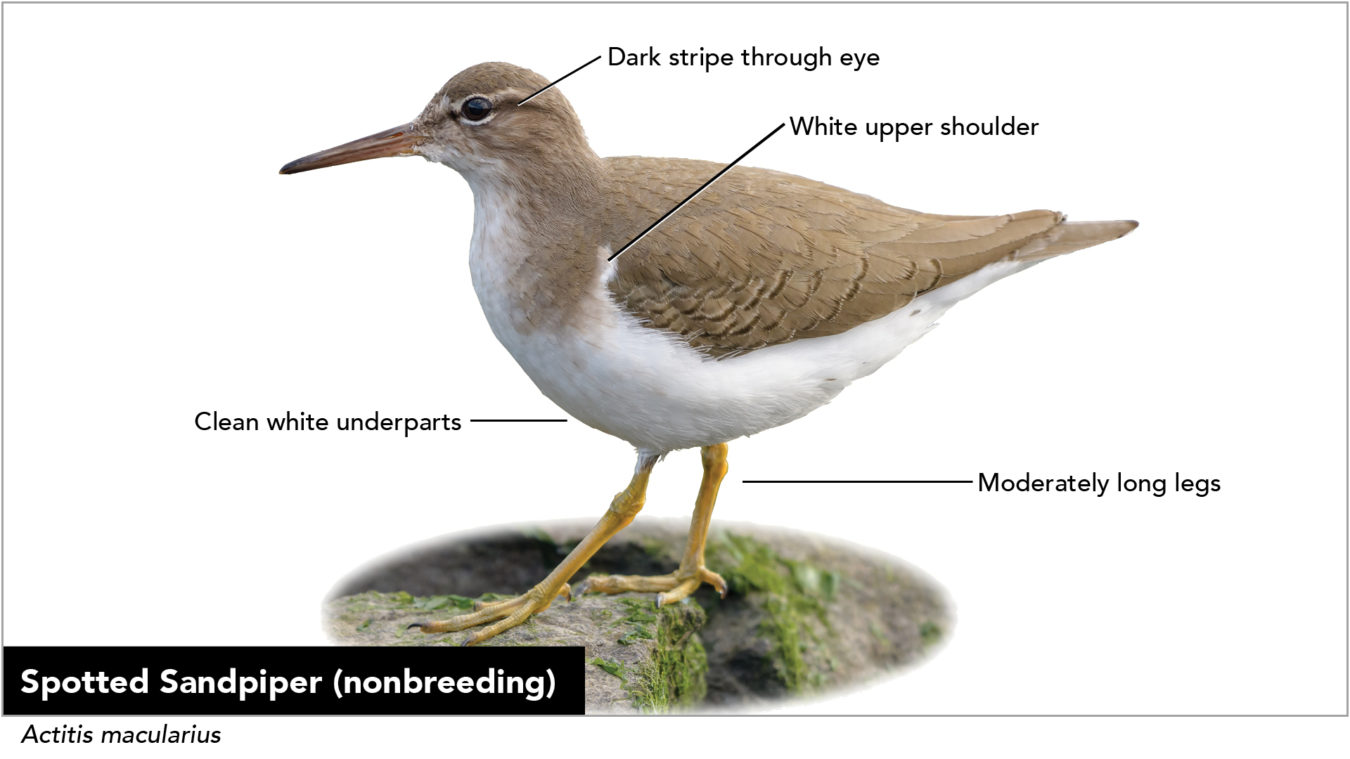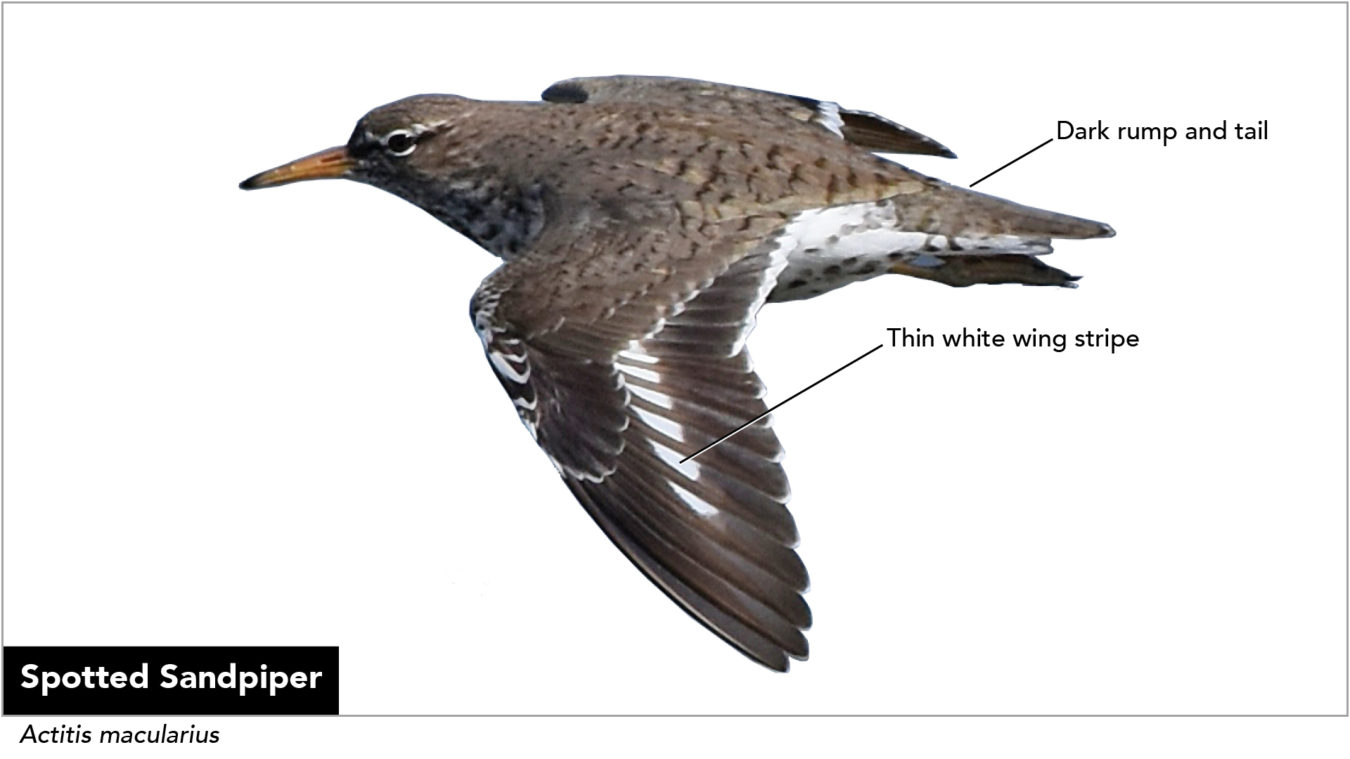Sample Lesson: Shorebird Identification
Explore this sample lesson on the Spotted Sandpiper from Be a Better Birder: Shorebird Identification. It’s just one of the 47 species covered in the self-paced online course.
It has a medium-length neck, medium-long legs, and a medium-long bill. It’s in the genus Actitis, but in structure it’s pretty similar to the Tringas, so I include it in my Tringa-types.
The nice thing about the Spotted Sandpiper is it’s conspicuously spotted in the summertime, and consequently, easy to identify if you get a good look at the chest. In breeding plumage, it has large dark spots on the chest, a dark back, a light eyebrow, and a dark stripe through the eye. It also has broken eyerings; that is, the eyering doesn’t go completely around the eye. It also has an orange beak. The females are the more strongly patterned individuals, and they’re the ones that defend the territories, while the males incubate the eggs.
In nonbreeding plumage and in juveniles, the chest and belly are plain white, and the back is dull brown, with barred upperwing coverts. Note also that white goes up the shoulder; that’s a distinctive mark. You can see a hint of that in the breeding plumage, too, but it really stands out in the nonbreeding and juvenile plumages. They have a dark bill and a dark stripe through the eye. Unlike in breeding birds, the eyebrow is not noticeably contrasting.
In flight, the Spotted Sandpiper has a strong wing stripe, and a dark rump and tail.
It does not congregate in flocks like many other shorebirds, but stays rather solitary. You can find a few near other shorebirds, but not in groups of concentrated Spotted Sandpipers.
The Spotted Sandpiper is commonly found along pond, lake, and stream edges. It can be found along the edges of mudflats, but it rarely goes to the beach. It’s much more common in freshwater than salt. But if you do see them at the beach, they’ll probably be on the rocks.
Like for many shorebirds, behavior is one of the best characteristics to use to identify the Spotted Sandpiper. It forages by walking and picking, and while it does, it’s constantly bobbing its rear end. Because they lean forward to pick, and constantly lift their tails in the air, I see the Spotted Sandpiper body making a triangular shape. Its flight style is distinctive too, when it flies short distances. It keeps its wings bowed down and makes very shallow wing beats. It looks like a windup toy as it flies. No other North American shorebird flies quite like that.
Its call is a short two- or three-noted whistle, PEEP-eep, PEEP-eep, accented and higher-pitched on the first note.
[Spotted Sandpiper calling]
The species most commonly confused with the Spotted Sandpiper is the Solitary Sandpiper. The two birds share a preference for smaller bodies of water and the edges of ponds, lakes, and streams. They’re close to the same size and shape, with the Solitary only slightly larger and with only slightly longer bill, neck, and legs, but that can be tough to distinguish in the field. There are a few differences in markings. On the ground, the Solitary does not show white up the shoulder like a Spotted. And the Solitary has a bold, complete eyering, while the Spotted has a thinner, broken eyering. In flight, only the Spotted has a white stripe in the wing, and the Solitary’s tail is barred, while the Spotted’s tail is solid. There are behavioral differences, too. In the air, Solitary Sandpiper flies in normal fast flight like most other shorebirds, not in the wing-quivering, toy-like fashion of the Spotted. On the ground, the Solitary does make periodic up-bobs of its upper body, but it doesn’t repeatedly bob its rear end the way a Spotted Sandpiper does.
The calls of the two species are similar, each a two-noted peeping. But the Spotted Sandpiper has a louder, higher-pitched first note PEEP-eep and Solitary has a higher, louder second note peep-EEP. Let’s listen to that.
[Spotted Sandpiper calling PEEP-eep] [Solitary Sandpiper calling peep-EEP]
Did you notice the difference?
Visual Keys to ID



Compare with Similar Species
These are the species commonly confused with the Spotted Sandpiper:

See more images with the All About Birds Species Comparison Tool
Practice for the Field
Bird Academy has developed a unique approach to learning bird identification. Our exclusive SnapID tool lets you practice identifying birds in all different postures and lighting conditions and builds your confidence for the field.
With SnapID, you get a chance to build up your own mental image of each bird for your brain to tuck away and reference later. If you pause on each pair of photos after you’ve chosen an answer and ask yourself, “What field mark did I use on that one?” you’ll quickly get a sense of which keys to ID are most helpful for you. Remember that each time you hit Play Again, you have new photo matchups to practice on.
SnapID: Choose the Spotted Sandpiper
Enroll in Shorebird Identification Now!
Thanks for previewing content from Shorebird Identification. The self-paced course offers materials like this for all 47 shorebird species in the continental U.S. and Canada, plus tips and techniques to build your confidence.
